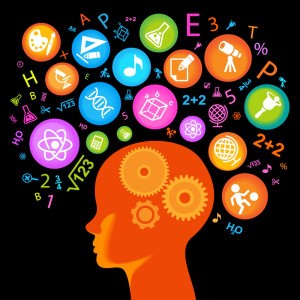By Maren Schmidt, Author of Understanding Montessori
Over the past 30 years, researchers have made great inroads into inner space, trying to figure out how our brains work.
Scientists know that certain parts of the brain control specific brain and body functions. Two hemispheres form the basic structure of the brain, connected by a bundle of neurons called the corpus callosum.
Between 24 to 48 months of age, the neurons in the primary motor cortex of the brain sprout a large number of dendrites, which are responsible for movement in the hands. The left motor cortex controls the right side of the body and right motor cortex controls the left side.
By the age of three years, 86% of children prefer to use the right hand more than the left. Researchers are looking into the proverbial chicken or egg question in regards to handedness. Does the use of the right hand create brain development in the left hemisphere and vice versa, or does brain growth create dominant hand use?
One thing we do know is that using the hands and brain development are closely connected.
We would be wise to help our children use their hands in as many ways as possible in order to maximize brain growth and brain hemisphere communication.
Research has shown that certain kinds of thinking are directed in each hemisphere. The functions of the right hemisphere are referred to as “right-brain thinking” and the work of the left hemisphere is called “left- brain thinking,” even though research shows that certain brain activities may occur in any part of the hemispheres. Some examples follow:
Right-Brain Thinking:
Intuitive, spontaneous, emotional, nonverbal, visual, artistic, holistic, playful, diffuse, symbolic, physical
Left-Brain Thinking:
Analytical, linear, explicit, sequential, verbal, concrete, rational, active, goal-oriented
Communication between the hemispheres occurs via the corpus callosum, which grows rapidly during the first six years of life. It is because of the corpus callosum that we can use our whole brains, and certain creative skills depend upon critical communication and perception shifts between the cerebral hemispheres.
We need to encourage activities that help develop our children’s corpus callosum by strengthening right/left brain connection. Walking, running and swimming are physical activities that require the functioning of both sides of the body and therefore stimulate both sides of the brain fairly equally.
Along with activities that use the whole body, we need to encourage activities that create cross-talk between the hemispheres of the brain.
For example, singing involves the right-brain function of music and the left-brain strength of language.
Verbally expressing emotion uses the right-brain function of emotion along with the verbal skills of the left brain.
Drawing graphs uses the right brain’s artistic function in tandem with the left brain’s analytical and mathematical skills.
Reciting nursery rhymes or poetry with motions takes advantage of the right brain’s predominance in motion and nonverbal skills while connecting with the left brain’s verbal skills.
Nursery rhymes and children’s songs have endured for centuries because they naturally address the brain development needs of the young child. By encouraging singing and learning a large variety of songs with your preschooler, you’ll also be encouraging the brain’s hemispheres to work together and strengthen vital connection through the corpus callosum.
Telling jokes uses the playful right brain and the verbal, goal-oriented left brain. If we can shift our joke telling at the right time to left-brain control, we’ll be more likely to remember and deliver the punch lines. Comedians rely on effective brain cross-talk to make us laugh.
Using whole brain communication can help us calm a crying or emotionally upset child. By softly counting into the child’s right ear, since the opposite side of the brain controls each side of the body, we begin to stimulate left-brain function, which is concerned with logic and rational thought. Because number work is a left-brain function, counting in the right ear helps the emotional right brain shift to a left-brain rational perception. This supports the old adage, “Count to ten when you are upset.” Counting helps us at any age to shift our thinking from our emotional right brain to our more rational left brain.
Singing can also help make the calming shift from right-brain to left-brain thinking. Keeping the right-hand side of a crying child next to you can help the child shift to a more left-brain perception.
In our children’s first six years of life, a time of rapid brain growth, let’s work to keep our children’s environments full of music, language and creative activities that will stimulate and nourish both sides of the brain and the connection between the hemispheres.

